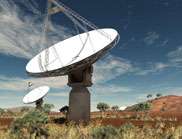CSIRO sets science path for new telescope

CSIRO has chosen the major science projects that its Australian SKA Pathfinder (ASKAP) telescope will tackle in its first five years.
ASKAP, being developed for a site in Western Australia, is expected to be fully operational in 2013. Construction is due to start later this year.
“ASKAP is open to projects from astronomers from all over the world, with projects determined according to their scientific merit, and operational feasibility,” CSIRO SKA Director Professor Brian Boyle said.
“Since 2008 we’ve had an open, international process to determine the key scientific questions ASKAP will address.”
During the telescope’s first five years at least 75 per cent of its time will be used for large Survey Science Projects, each needing more than 1500 hours to complete and designed to take advantage of ASKAP’s unique capabilities.
“An international panel of expert astronomers picked the 10 top projects that will take advantage of ASKAP’s huge survey speed and large field of view,” Acting Director of the Australia Telescope National Facility Dr Lewis Ball said.
“These projects address widely recognised astrophysical issues and their results will be important for the broad astronomical community.”
A breakdown of the 10 projects illustrates the international interest in the ASKAP program.
The projects represent 363 unique authors from 131 institutions. The breakdown of unique authors by region was 33 per cent Australia and New Zealand, 30 per cent North America, Europe 28 per cent, 9 per cent rest of world.
Two of the top 10 projects are an Evolutionary Map of the Universe (EMU) and the Widefield ASKAP L-Band Legacy All-Sky Blind Survey (WALLABY).
EMU is a deep survey for star-forming galaxies and active galactic nuclei, designed to trace the evolution of star-forming galaxies and massive black holes through the history of the Universe.
WALLABY is a survey for galaxies containing neutral hydrogen gas over 75 per cent of the entire sky, and is aimed at improving our understanding of galaxy formation.
Other Survey Science Projects will study variable and transient radio sources, the interstellar medium of our own Galaxy, magnetic fields in space, and pulsars.
A complete list of the projects can be found at:
ASKAP, as well as being a world-leading telescope in its own right, will be an important test-bed for the future Square Kilometre Array (SKA), an international radio telescope that when built, will be the world’s largest and most powerful.
Provided by CSIRO ( : )



















